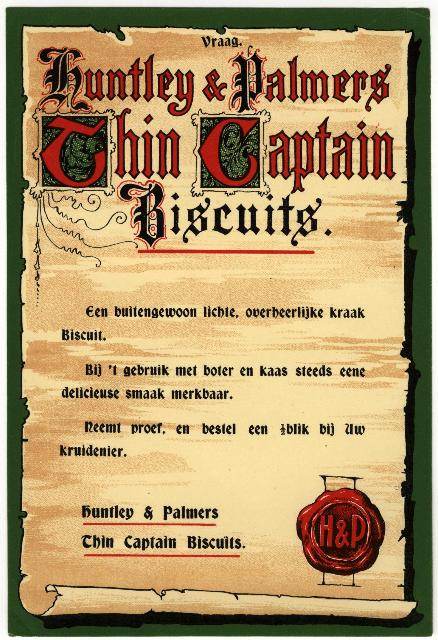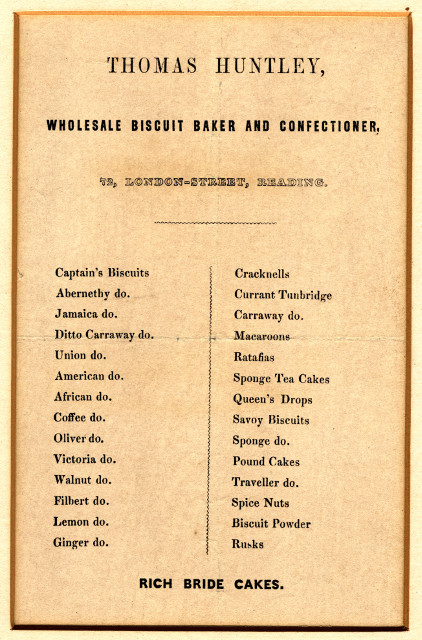The word biscuit comes from the Latin for 'cook twice' because the biscuit-making process has two steps: baking the biscuits and then leaving them to dry, which removes moisture. It is this process that creates their long life.
The expansion in sea travel from the sixteenth century onwards led to the development of the biscuit as we know it today. Owing to its nutritional properties and its longevity, the biscuit soon became indispensable to sailors on long voyages.

Thin Captain was a "fancy biscuit" variety, whose name reflected its maritime origins. This early 20th century advert, in Dutch, boasts of its exceptional lightness and delicious crunchiness. (REDMG : 1997.82.178)
From the beginning of the nineteenth century, Huntley & Palmers began to produce 'fancy biscuits'. The main varieties were Captain, Water, and Cabin. As the names suggest, they owed much to the traditional ship's biscuit. At the same time, many people had recognised the health benefits of biscuits since the 1600s, and Huntley & Palmers named some products after notable doctors and physicians.
Huntley's first biscuits
In the 1820s, the London Street bakery owned by Joseph Huntley was one of three Reading shops that specialised in biscuit-baking. Most of the thirty other bakers in the town made at least some biscuits.
Huntley began on a small scale. Baking needed no more than a quart of milk per day, and a sack of flour lasted six months.

This is one of the earliest surviving advertisements for Thomas Huntley's biscuit bakery in London Street, from the 1830s. Huntley sold his biscuits to hungry coach travellers who stopped at the Crown coaching inn near to his shop. (REDMG : 1997.130.57)
By the late 1830s the firm was selling about twenty different kinds of biscuit, from the Captain's, Abernethy and Oliver varieties to the more choice Cracknels, Macaroons, Ratafias and Sponge Tea Cakes. In addition it made four kinds of cake mostly produced in batches according to demand. There was also one or two items of confectionary including fancy bread rolls and some seasonal products such as Hot Cross Buns and Twelfth Night cakes.
Patent Unfermented Bread
In March 1844, in a bid to increase profits, Huntley & Palmers paid £50 for the right to make and sell patent unfermented bread within five and a half miles of Reading. In place of yeast, the bread contained hydrochloric acid and carbonate of soda. The new type of bread was an immediate success and led to a rise in profits which exceeded £1000 for the first time in 1845-46.
Read on to find out about Huntley & Palmers' many biscuits for all occasions.





